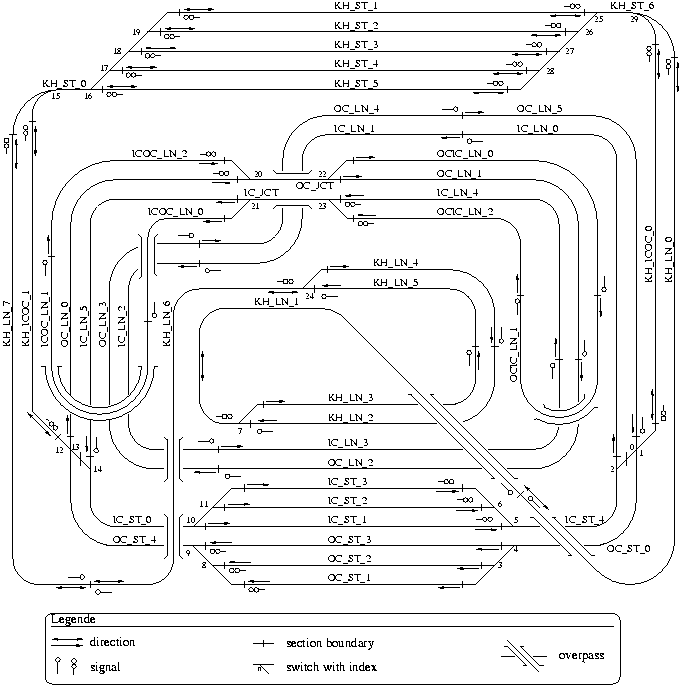![]() The conceptual
background
The conceptual
background
![]()
![]() The track system
The track system
![]()
![]() The operating principle
The operating principle
![]()
![]() The interbus system
The interbus system
![]()
![]() The control program
The control program
![]()
![]() Some photographs
Some photographs
The model train system
The track system
The complete track layout is depicted in the diagram below which closely mirrors a bird eye's view. It basically consists of three circular tracks, of which one - called the pass - is operated bidirectionally, and two - the main tracks - are operated unidirectionally.

track layout diagram (pdf version)
Beginning at the top, we have a switchyard of five sidings, labeled KH_ST_1 to KH_ST_5, from which trains may enter the bidirectional pass track KH_LN_.. in both directions (clockwise and counterclockwise), and to which they must return eventually. The pass track itself, whose eight sections are labeled KH_LN_0 (the rightmost vertical line of the diagram) to KH_LN_7 (the leftmost vertical line in the diagram), crosses twice the main tracks. It forms a loop, shown in the center of the diagram, which halfway through branches into two sidings, one including the sections KH_LN_2 and KH_LN_4, the other including the sections KH_LN_3 and KH_LN_5, in which trains moving in opposite directions may bypass each other.
At the bottom we have two switchyards of three sidings each, labeled OC_ST_1 to OC_ST_3 and IC_ST_1 to IC_ST_3, which are the starting and return points of the pair of circular main tracks. These tracks run in parallel, forming a double loop to achieve some reasonable length on limited real estate, and are operated in opposite directions. Trains in the outer main track labeled OC_LN_.. move clockwise, trains in the inner main track labeled IC_LN_.. travel counterclockwise, as indicated by the little arrows.
Trains may switch between either of the main tracks and the pass track through the track sections KH_ICOC_0 (the second vertical line from the right) or KH_ICOC_1 (the second vertical line from the left) and through the KH_ST_.. switchyard. The direction in which a train moves along the pass track is determined by the direction in which it arrives from either of the main tracks. A train leaving the KH_ST_.. switchyard counterclockwise through the track KH_ICOC_1 is routed into the IC_.. main track, likewise, a train leaving the KH_ST_.. switchyard clockwise through the track KH_ICOC_0 is routed into the OC_.. main track. There are also two loops ICOC_LN_.. (on the left) and OCIC_LN_.. (on the right) through which trains may switch between the inner and the outer main tracks and thus change directions.
The main tracks and the pass track are about 22 meters long (not including the switchyards) and partitioned into six sections (blocks) each. The time for a train to complete a full cycle on each track is about two minutes.
The entire track system covers an area of about 18 square meters, the total length of the tracks is roughly 100 meters, partitioned into 47 sections (or blocks) of from 1 to 3 meters length, and there are 28 switches. It has been implemented using exclusively ROCO gauge HO low profile rail material throughout.
The rolling stock is ROCO equipment as well; the locomotives are simple diesel engine models - the cheapest we could get - which by now have all gone a real distance of more than 22 kilometers. They are - very conventionally - driven by DC voltages applied to the track sections, which are electrically insulated from each other for individual control of trains passing through them.
30.07.2003